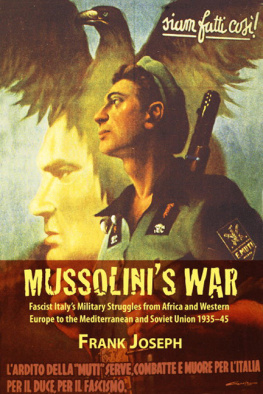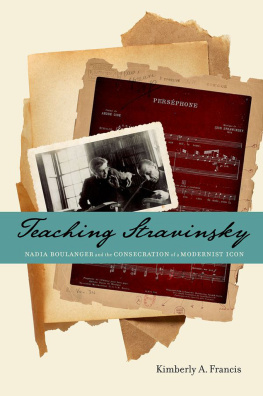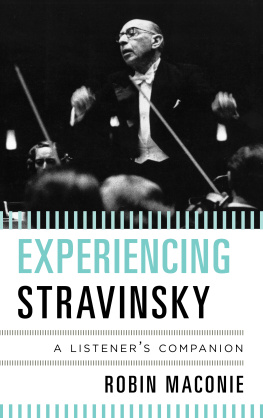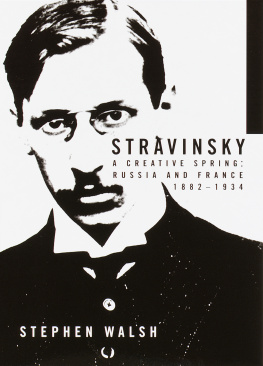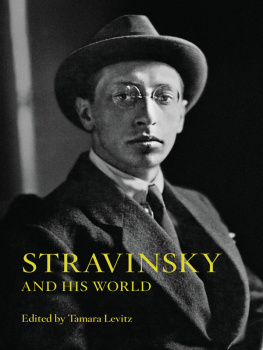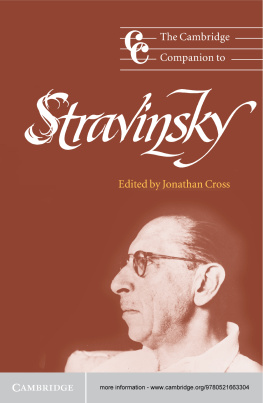Joseph - Stravinsky Inside Out
Here you can read online Joseph - Stravinsky Inside Out full text of the book (entire story) in english for free. Download pdf and epub, get meaning, cover and reviews about this ebook. year: 2001, publisher: YaleUP, genre: Detective and thriller. Description of the work, (preface) as well as reviews are available. Best literature library LitArk.com created for fans of good reading and offers a wide selection of genres:
Romance novel
Science fiction
Adventure
Detective
Science
History
Home and family
Prose
Art
Politics
Computer
Non-fiction
Religion
Business
Children
Humor
Choose a favorite category and find really read worthwhile books. Enjoy immersion in the world of imagination, feel the emotions of the characters or learn something new for yourself, make an fascinating discovery.

- Book:Stravinsky Inside Out
- Author:
- Publisher:YaleUP
- Genre:
- Year:2001
- Rating:5 / 5
- Favourites:Add to favourites
- Your mark:
- 100
- 1
- 2
- 3
- 4
- 5
Stravinsky Inside Out: summary, description and annotation
We offer to read an annotation, description, summary or preface (depends on what the author of the book "Stravinsky Inside Out" wrote himself). If you haven't found the necessary information about the book — write in the comments, we will try to find it.
Stravinsky Inside Out — read online for free the complete book (whole text) full work
Below is the text of the book, divided by pages. System saving the place of the last page read, allows you to conveniently read the book "Stravinsky Inside Out" online for free, without having to search again every time where you left off. Put a bookmark, and you can go to the page where you finished reading at any time.
Font size:
Interval:
Bookmark:
Stravinsky Inside Out

Charles M. Joseph.

Title page photograph: Igor Stravinsky in 1934 (Photograph by George Hoyningen-Huene; courtesy of the Harvard Theatre Collection)
Copyright 2001 by Yale University.
All rights reserved.
This book may not be reproduced, in whole or in part, including illustrations, in any form (beyond that copying permitted by Sections 107 and 108 of the U.S. Copyright Law and except by reviewers for the public press), without written permission from the publishers.
Designed by James J. Johnson and set in Fairfield Medium type by The Composing Room of Michigan, Inc. Printed in the United States of America by R. R. Donnelly & Sons.
Library of Congress Cataloging-in-Publication Data
Joseph, Charles M. Stravinsky inside out / Charles M. Joseph
p. cm.
Includes bibliographical references and index.
ISBN 0-300-07537-5 (alk. paper)
1. Stravinsky, Igor, 1882-1971. 2. ComposersBiography. I. Title.
ML410.S932 J68 2001
780'.92dc21 2001000913
A catalog record for this book is available from the British Library.
The paper in this book meets the guidelines for permanence and durability of the Committee on Production Guidelines for Book Longevity of the Council on Library Resources.
10 9 8 7 6 5 4 3 2 1
For Lucy
CHAPTER 1
Truths and Illusions: Rethinking What We Know
CHAPTER 2
Rediscovering the American Apollon Musagte: Stravinsky, Coolidge, and the Forgotten Washington Connection
CHAPTER 3
Fathers and Sons: Remembering Sviatoslav Soulima
CHAPTER 4
The Would-Be Hollywood Composer: Stravinsky, the Literati, and the Dream Factory
CHAPTER 5
Television and The Flood: Anatomy of an Inglorious Flop
CHAPTER 6
Film Documentaries: The Composer On and Off Camera
CHAPTER 7
Letters, Books, Private Thoughts: Reading Between the Lines
CHAPTER 8
Boswellizing an Icon: Stravinsky, Craft, and the Historians Dilemma
Every age produces individuals destined to shape the cultural history of their times. Igor Stravinsky (18821971) was such a person. The mere mention of his name, like the name Beethoven, immediately triggers a flood of imagessome accurate, others not. His presence defined many of the fundamental concerns, ideas, and attitudes not only of twentieth-century composers but of twentieth-century art. He captured the imagination of the age in a way that only Picasso and a few other contemporaries were able to do. The proliferation of superlatives that music history attaches to Stravinsky, however, consists of truths and fictions mingled so freely that distinguishing between the two presents a formidable challenge. Was he the centurys greatest composer? Should he be considered a genius, an intellectual, an ideologue, an iconoclast, or just a hardworking artisan? How did he become such a powerful figurean enigmatic icon, for somecapable of commanding the artistic worlds attention over a large span of the century? In trying to answer these questions, we must first separate the public and the private man, for at times Stravinsky appears to have been two very different people.
Mythmaking is a calculated art, rooted in our need to create images and heroes. The forces that contributed to the mythologizing of Stravinsky are complex. How much did the composer, and those around him, consciously create the kind of protective blanket that often cloaks the real person? More broadly, what might this say about the changing cultural role of artists in our time? Was it the strength of Stravinskys unquestioned musical achievements alone that elevated him to the status of an icon; or did the promotion of his image help to lift him to such a plateau? As art historian Alessandra Comini writes in The Changing Image of Beethoven: Why Beethoven ... became the paradigm of Germanic musical genius for nineteenth-century Europe has as much to do, and perhaps even more so, with posteritys perception of his life and character as it does with an appreciation of his musical achievements, towering as they were. Like Beethoven, and Picasso too, Stravinsky did little to resist the perception of his reputation as a courageous artist ready to defy precedent in the face of criticism.
The composers life was shaped by an unusually swift succession of epoch-making events in a century characterized by constant dynamic change. His personal life was also marked by one upheaval after another, demanding the need for adaptability if he was to survive. Eventually the many pathways in his career led to the United States, where his Americanization dramatically influenced his actions and decisions, both personally and musically. To ignore the politics of the age, to disregard the centurys many technological explosions, to underestimate the social context in which he participated as a very public figure, only crystallizes the many half-truths that swirl around his image. Stravinsky did not work in isolation, churning out one masterpiece after another, insulated from the rapidly evolving world in which he lived. To operate on such a naive assumption is to insult the inquisitive, rational, impassioned, pragmatic, and very human person that he was.
I have come to think about these issues only recently, for this is not the book I originally set out to write. Years ago I prepared a monograph on the composers piano music, but without the benefit of his then unavailable sketches and drafts. Following Stravinskys death, I awaited the settlement of his estate, hoping to study the manuscript sources. During the interim, and as a happy consequence of moving to Saratoga Springsa city with a rich dance traditiona new interest emerged. With a growing affection for dance sparked by my daughter Jennifers love of ballet, I began exploring the Stravinsky and Balanchine partnership (about which I shall have more to say in a forthcoming book). When the Stravinsky archives in Basel, Switzerland, were opened to scholars in the 1980s, I began traveling regularly to the Paul Sacher Stiftung, where quite unexpectedly I stumbled across aspects of Stravinskys life about which I either knew nothing or had entirely misperceived, particularly given what presumably reliable studies of the composer had related.
During several residencies in Basel, I sorted through thousands of unpublished documents. I read hundreds of unpublished letters, viewed hours of unreleased film clips, perused Stravinskys library, and examined his informative annotations and marginalia. Each archival file brought new questions about the composers interactions with others, his habits, his agenda, and often his privately expressed thoughts, some of which have been judiciously suppressed from the public record. Was this the same Stravinsky whose music I first encountered as a teenager, the same colossus of the twentieth century whose eminence is affirmed in virtually every music history text? Not only did I begin to sense that the composers private life was at odds with his public image, but I quickly came to understand that the cultural context into which history so blithely drops him is too narrow, too pat, and consequently often skewed.
It was Stravinskys music, of course, that first attracted medazzling pieces like The Firebird and the other early Russian ballets so familiar to musicians and nonmusicians alike. It was the energy of his rhythms, his punctuating silences, the kaleidoscopic colors of his orchestration, and the overall boldness of his musical language that enthralled me. It still enthralls me, both emotionally and intellectually. I confess this now, for in the pages that follow I do not address Stravinskys music in any substantive manner. This is not a book intended primarily for musicians, whose grasp of musical syntax naturally shapes discussions of the composers works in instructive but, necessarily, exclusionary ways. There are no musical examples, no compositional analyses to decode. Nor do I pretend to offer a musicological overview of the composer. Rather, I wish to revisit selected aspects of the composers historicized imagea bequeathed image that continues to reverberate with almost scriptural authority. Mark Twain once quipped, Its not what we dont know that hurts us; rather, what gets us into trouble is what we are absolutely certain of that just aint so. Much that is written about Stravinsky distorts as much as it clarifies.
Next pageFont size:
Interval:
Bookmark:
Similar books «Stravinsky Inside Out»
Look at similar books to Stravinsky Inside Out. We have selected literature similar in name and meaning in the hope of providing readers with more options to find new, interesting, not yet read works.
Discussion, reviews of the book Stravinsky Inside Out and just readers' own opinions. Leave your comments, write what you think about the work, its meaning or the main characters. Specify what exactly you liked and what you didn't like, and why you think so.

